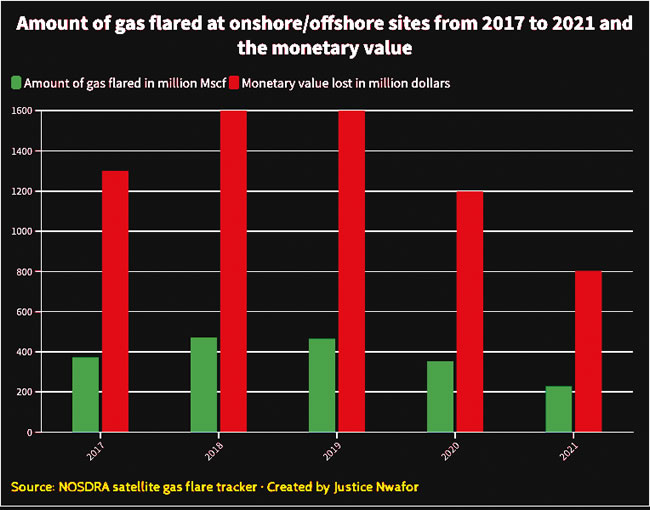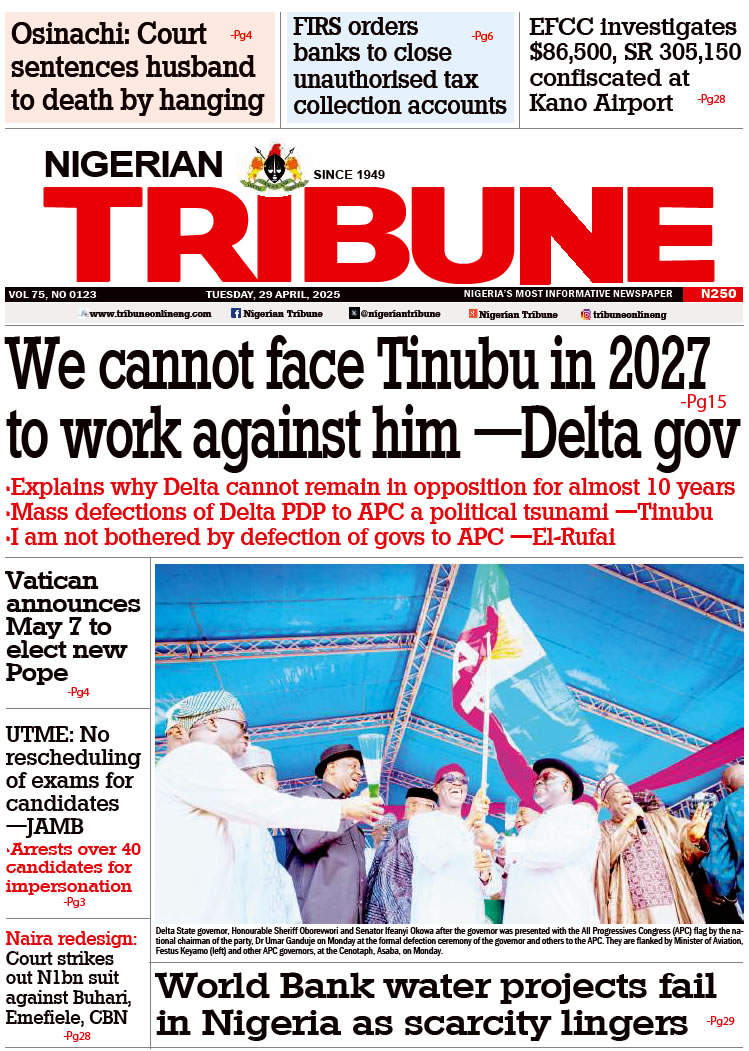In December 2016, the Nigerian government inaugurated the Nigeria Gas Flare Commercialisation Programme (NGFCP) with the aim to stop gas flaring in 2020. Five years later, gas flaring is still rife in the country. In this report, JUSTICE NWAFOR analyses satellite gas flaring data from 2017 to 2021 and finds that Nigeria lost N2.7 trillion to the flares and illustrated what the missed sum would have done for Nigerians.
When Nigeria’s Federal Executive Council (FEC) approved the Nigeria Gas Flare Commercialisation Programme (NGFCP) in 2016, the intention was straightforward — to use a market-based mechanism to eliminate gas flare. From this simple intention, multilayered results were expected.
First, flaring gas equals burning off money Nigeria desperately needs. So, the first layer of the NGFCP’s purpose was to license companies to take off the hitherto flared gas and sell and then pay the Nigerian government for it: help Nigeria fix its revenue crisis.
The next layer is to cut CO2 emissions. When gas is flared, CO2 is released into the atmosphere and it significantly contributes to global warming which has had devastating impacts on the climate and lifestyles of billions of people around the world. In fact, Nigeria is one of the countries expected to be worst-hit by irregular rainfall patterns, rising sea levels, heatwaves and flooding — all consequences of climate change.
Though it contributes less than one per cent to the global CO2 emission, over the years, Nigeria’s emissions have spiked significantly. For instance, the country’s CO2 emissions almost quadrupled between 1990 and 2019, from 28 million tonnes of carbon dioxide per year to 92 million. Moreso, the country has not hidden its support for net-zero emission by 2050 — a goal the world needs to meet to limit global temperatures to 1.5C. The programme is part of the country’s plans to cut emissions.
There is an electricity crisis in Nigeria. About 80 million Nigerians — more than the number of people living in Australia, Rwanda, Belgium, Netherlands and Sweden combined — do not have access to electricity. This is because of the country’s poor generation, transmission and distribution infrastructure.
Of generation, about two-thirds of the power generation companies in Nigeria are gas-fired. But their operations have been stymied by inadequate gas supply. For instance, in March this year, the power sector lost N6.868 billion in seven days and N1.707 billion in one day in January this year due to challenges associated with insufficient gas supply. So, the third layer of the gas commercialisation programme is to help fix the gas supply challenge and make power accessible to more Nigerians.
How gas flaring started
The gas flare, which takes place in Nigeria, is mostly of the Associated Gas (AG) — the gas which comes alongside drilled crude oil. The first flare could be traced to Oloibiri, in present Bayelsa State, where drilling successfully started in 1959.
AG, which is inextricably lifted with crude, must either be harvested or disposed of onsite as an unwanted by-product of oil. As of then, there were rarely facilities that could harvest it. So, disposing of it became the major option.
As more development came, harvesting became possible but disposing of was the cheaper option. So, the flaring continued. It went on so much so that there are now more than 170 flare sites that collectively flare about 330 bscf of gas annually, according to the Nigerian Upstream Petroleum Regulatory Commission (NUPRC) formerly the Department for Petroleum Resources (DPR).
Abandoned bids
After the programme’s launch, the NUPRC called for bidders. Then the call for the Statement of Qualification followed. Before the initial deadline expired, it extended the deadline to the end of February 2019. Specifically, it reiterated the timeline for the remaining events that would lead to the final selection of bidders: a shortlist of qualified applicants would take place in the second quarter of 2019, issue of request for proposal would also be in the same quarter while submission of proposals would be in the third quarter. The selection of preferred bidders would then be in the fourth quarter of the year.
But the timeline has been truncated. Although 203 names out of the entire firms which participated in the Statement of Qualification process were later released as successful firms, nothing much has been heard of the programme of late.
It is now about 24 months outside the working timeline, yet nothing has been heard of the process and programme.
This reporter reached out to the spokesperson of the NUPRC, Mr Paul Usoh but got no response. Calls were made and SMS was sent to his contact phone number, but Mr Usoh responded to none.
There are implications
To put the opportunity cost of this failure in the right perspective, this reporter analysed gas flare data of all onshore and offshore flare sites from January 2017 to November 2021 obtained from the National Oil Spill Detection and Response Agency’s (NOSDRA) gas flare tracker.
Within the selected period, the tracker recorded that 1.9 billion Mscf of gas valued at $6.6 billion — an average of $1.32 billion every year for five years — was flared. This amounts to N2.7 trillion at the exchange rate of N411 to a dollar. This is a huge amount given that Nigeria, for the past few years, has been borrowing to finance its annual budget.
This amount is a little above a fourth of the initial loan of $1.5 billion Nigeria took for the Lagos-Ibadan railway project. It is more than the entire capital budget of the country in 2019 (N2.14 trillion) and about half of 2022’s N5.4 trillion.
Down to smaller projects that would have impacted the average Nigerian, this failure is a big miss. To make it clearer, a project carried out in 2016 by the National Primary Health Care Development Agency (NPHCDA) — the construction of a type two PHC at College of Education in Akwanga LGA of Nasarawa State — would be used to illustrate how much impact the lost sum would have had. The project had a budget amount of N49 million.
At N49 million, our analysis revealed that N500 billion from the lost sum would have constructed not less than 10,204 type 2 primary healthcare centres. It simply means that each of the 36 states and Abuja would have got at least 275 functional primary healthcare centres.
Another project carried out in 2016 by the NPHCDA — the drilling of a motorised borehole at Ima Area, Ilobu, Irepodun LGA of Osun State — would be used to estimate the impact of the missed sum.
The project was at a contract amount of N10 million. At this amount, if N100 billion of the lost sum was used to drill boreholes in most rural communities with no access to clean water, there would have been about 10 thousand new and functional boreholes in far-to-reach villages across Nigeria. It means that 270 villages in 36 states and Abuja, respectively, would have gotten a functional borehole and Nigeria would have been better prepared to fight the incessant outbreak of Cholera.
Also, from the missed sum, the second Niger bridge project, N414 billion; the Lagos-Ibadan road, N311 billion; the east-west road, N1 trillion, would have been constructed.
Still from the missed sum, Bama to Banki road for N51.016 billion; Dikwa to Gamboru-Ngala, for N55.504 billion; Nnamdi Azikiwe road in Kaduna for N37.560 billion; the deep seaport access road sections one and three in Lagos State, through Epe to Shagamu Expressway, for N85.838 billion and the Obele/Ilaro/Papalanto to Shagamu road, for N79.996 billion, would have been constructed.
For Paul Alaje, Senior Economist at SPM Professionals, the implications go beyond the forgone funds. The failure of the programme and continuation of gas flare in the country perpetuates poverty, he says.
“In the real sense, are we truly in need of money or we are failing to pick the money where they are?”, Alaje asked. “I think we are not ready to pick our money from where they are”, he says.
While the programme has failed to yield fruits, the appropriate penalties should be collected from the companies, he advised. In fact, according to data from the tracker, penalties payable for the flares amount to $3.8 billion. But the government is not able to collect the penalties, Alaje says.
100.6 million tonnes of CO2 emissions flared, 89.4 thousand GWh of power generation potential wasted
Another layer to this miss is the environmental implication. Nigeria has been a vocal voice in cutting emissions globally. In fact, it had hoped to end gas flaring in 2020, a decade before the global ‘Zero Routine Flaring by 2030’. It is party to the Paris Agreement, haven signed the agreement in 2017.
Also, the country has promised to cut emissions 20 per cent by 2030 compared with business-as-usual levels, increasing to a 47 per cent cut below business-as-usual by 2030, depending on whether it receives international financial support. At the UN’s global climate talks in Glasgow, COP26, it made a pledge to reach net-zero emissions by 2060.
The country clearly is involved in the fight to have a green climate, that’s why this miss cuts really deep. Data from the tracker says within the period reviewed, Nigeria flared 100.6 million tonnes of CO2.
Moreso, 89.4 thousand GWh of power generation potential was wasted during the period. This is a huge miss given that close to half of Nigeria’s 200 million population does not have access to electricity. Even those who have, endure blighting cuts, forcing them to rely on smoke-belching petrol and diesel-powered generators.
This reliance costs the country, especially small businesses a lot: a 2019 IMF report found the power crisis costs Nigeria $29 billion annually.
Alaje, the senior economist at SPM Professionals, says this link between gas flaring, the high mortality rate of small businesses and poverty can be broken when flaring stops.
“When the environment is affected, human resources are directly affected. When human resources are affected, the economy is affected; and it will trickle down to the livelihood of the people”, he says.
YOU SHOULD NOT MISS THESE HEADLINES FROM NIGERIAN TRIBUNE
FALSE! Yoruba Not An Official Language In Brazil
Claim: A national newspaper and multiple online platforms claim Brazil has adopted Yoruba as its official language and that the language would be included in primary and secondary schools curriculum.
Verdict: The claim is false. The content of the article published by these online platforms is not new; it has been recirculated several times and has been debunked.
Viral Voice Note On WhatsApp Billing False
Claim: A viral WhatsApp voice note, purportedly made by the director and CEO of WhatsApp, claims users will have to start paying for WhatsApp services.
Verdict: The viral WhatsApp voice note claim is a hoax. The content is not new and has been circulated as a broadcast message several times in the past.
Marburg Virus: What You Need To Know About Disease Recently Detected In West Africa
On Monday, August 9, 2021, the World Health Organisation (WHO) confirmed the first case of Marburg virus in West Africa in Guinea. This development has sent shivers down the spines of West Africans who are still grappling with the effects of the coronavirus pandemic. But before this dreaded disease is greeted by rumours and misinformation, here is what you have to know about the virus.
FACT CHECK: US Did Not Give Nigeria 48 Hours Ultimatum To Detain Abba Kyari
CLAIM: Several social media posts claim the United States of America (USA) gave Nigeria’s Federal Government 48 hours to detain suspended Deputy Police Commissioner, Abba Kyari, or face severe sanctions.
VERDICT: The claim is false and misleading. The US did not give Nigerian Federal Government 48 hours ultimatum to detain Abba Kyari.




